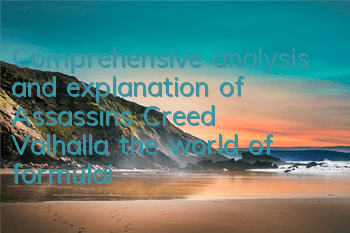After about 8 hours of artistic creation by Australian artists, Ubisoft officially announced the information about the latest work in the Assassin's Creed series - "Assassin's Creed: Valhalla". The Assassin's Creed series, which has attracted much attention from players, finally returned to the vision of the majority of players after a brief silence.
Now, the new work of "Assassin's Creed" has released a lot of information, and the speculation and analysis of the relevant content of this work has become a topic that many players are interested in. I don’t know where to start, a large number of players began to fight against the open world design in Ubisoft’s games.
Where the term "formalized open world" comes from?
We must mention Gamker's Ghost in the Shell here, it is a game self-media destined to be recorded in the history of Chinese gaming.
In September 2015, Gamker first proposed the concept of "Ubisoft-style open world", which was later the concept of "formalized open world" in the program "In-depth Commentary on Mad Max".
In view of this concept, Gamker gave an explanation:
First of all, they will not carefully design every inch of land on the map. They will only design an approximate scene, then design 5 to 10 collection elements, and then distribute these collection elements to every corner of the map repeatedly, randomly and evenly, and then they will not carefully design plot tasks for players to slowly feel the world. Open the treasure chest, capture the enemy camp, occupy the commanding heights, obtain a building, and talk to someone, and the rest is repeating. What's even more annoying is that these duplicate elements are all marked on the map. (There are deletion and modification)
Program Screenshot
So it is not difficult to find that the so-called "formalized open world" contains several elements of the open world: large maps, many NPCs, alternating day and night, etc.. It also has elements that greatly affect the player's gaming experience, such as repeated map design, excessive collection elements, same side mission design, etc.. For players, the virtual world that should have experienced a truly "open" will appear to be useless due to the constraints of these elements. It is a pity to abandon it if you eat it tastes tasteless.
Ghost Recon: The Wilderness is a typical example
As we all know, many Ubisoft's games have been disliked by countless players because of their "formalized" open world design, but in fact, many game manufacturers are also trying out this kind of open world design, including the famous "Self-Defense" series, "Marvel Spider-Man" on PS4 and other games. These games have given countless players a big negative review due to the so-called "formalized open world" design.
"Liberal Defense 3"
Has Assassin's Creed become "formalized"?
The virtual world of the Assassin's Creed series has never been so free and open. Since Assassin's Creed 2, feathers and manuscripts have caused headaches for many players. The cleanup of strongholds that "Assassin's Creed 2: Brotherhood" has made many players feel "deeply aversion" about the city of Rome. Searching for treasures on vast seas and some islands in "Assassin's Creed: Black Flag" also makes it difficult for many players to accept. Then to the "Assassin's Creed: Odyssey", which is now full of question marks, they have similarities in the design of side missions (including tasks such as cleaning up strongholds, collecting items, etc.).
Assassin's Creed: Odyssey
The world of the Assassin's Creed series has always been the product of the "Ubisoft-style open world". Whether it is the feathers, chests and manuscripts in Assassin's Creed 2, treasure chests, badges and artifacts in Assassin's Creed Revolution, or the countless points and question marks in Assassin's Creed Odyssey, these elements have never been separated from the Assassin's Creed series, but have become an important part of the game and become part of the time many players spend in the game.
I believe many players are upset about the collection of manuscripts in Assassin's Creed 2
For players who like to collect elements and enjoy slowly the story and worldview of the game, the Open World in the Assassin's Creed series is a delicacy that suits these players' appetites. For players who hate collecting elements and are willing to stealth or fight, such "New Year's goods" works obviously cannot withstand long-term play. Ubisoft also discovered that the Assassin's Creed series, as a "New Year's goods", urgently needs a major transformation to become an excellent open-world game that can stand the test of time like Red Dead Redemption 2 or GTA5. The new work "Assassin's Creed: Valhalla" is the product of this major transformation.
What is the open world of the new work?
The scale of the Assassin's Creed series maps is getting bigger and bigger, which obviously will not change. Therefore, it is inevitable that the map in Assassin's Creed: Valhalla will exceed Assassin's Creed: Odyssey. With the addition of Viking elements, the ocean scenes in the game account for a large proportion (after all, large areas of sea wars are required).
Assassin's Creed: Odyssey's Naval Battle
In addition, Ubisoft used 15 studios to participate in the development of "Assassin's Creed: Valhalla", and also led the "Ace Studio" known as Ubisoft's hands - Montreal Studioleading. This may indicate that the quality of this work will be improved in an all-round way and will be separated from the "formalized open world", but in fact, the latter still needs to be considered.
In the predecessor of Assassin's Creed: Odyssey, Ubisoft also used multiple studios to participate in the game development. The design of each studio for the entire open world is limited to each different area in the corresponding map of each studio. In short, each studio is responsible for the development of one area. The final result is that the map of the entire game is much bigger than that of Assassin's Creed: The Hero. Compared with the Quebec Studio's "Assassin's Creed: The Hero" and "Assassin's Creed: Odyssey", complex issues such as collecting elements and clearing up strongholds are indeed improved, but it is still far from the dynamic open world that players fantasize about. What's more, the release of its sequel, Assassin's Creed: Odyssey, once again pulls this series into the quagmire of the so-called "formalized open world".
Assassin's Creed: Origins Map
Therefore, the design of the various British kingdoms in Assassin's Creed: Valhalla, developed by Montreal Studios, will have a certain similarity in the design of the regions where the British kingdoms are located, but it will also be as vivid and eye-catching as the Nile Valley in Assassin's Creed: Origins. In addition, an important part of the "formalized open world" - "collecting elements" will definitely be an indispensable part of the game. At least for players, a vast map means more items that need to be collected. At the same time, the setting of the background of the "Viking Conquest" era is destined to mean that the clearing of strongholds (or regional competition) will become the highlight of the game. How Ubisoft Montreal Studios can make players happy to participate in the bloody battle and be willing to fight the Anglo-Saxons to promote the main plot can only be officially announced until the trial video is announced or released.
Assassin's Creed: Valhalla poster
But one thing worth mentioning, recently it was revealed that "portal" settings such as the Beautiful Age in Assassin's Creed: Valhalla will be added to "Assassin's Creed: The Great Revolution" and the German-occupation Paris during World War II or the Battle of London in "Assassin's Creed: The Heroes", which means that we can explore a wider world besides the initial map. Such a setting may bring us more surprises.
A Battle with London in Assassin's Creed: The Heroes
The virtual world built by Ubisoft is seeking change
After many games suffered from Waterloo, Ubisoft obviously realized the seriousness of the various designs in the game, including excessive collection of elements and repetitive scene design. For players who pursue personalized NPCs, dynamic open worlds and other elements, the beautiful scenery and the historical sites that use reality as reference are obviously alreadyCan't satisfy current players.
Ubisoft released "Watch Dogs 3" last year expressed a breakthrough in the original open world model, including unique NPCs, relevant scenarios and events. Ubisoft hopes to break the prejudice of many players towards the "Ubisoft-style open world" through this work, but the delay in the release of the work seems to indicate that Ubisoft is not ready to satisfy all players. But it can be seen from this that Ubisoft is seeking changes to the content of the original series of works, and hopes to change the attitude of many players towards Ubisoft through this change.
"Watchdog 3"
Assassin's Creed: Valhalla, as the latest work in the 2020 Ubisoft's signature game series, whether it can re-establish this work as the "peak" of the series in terms of open world design and control of game content is still worthy of all players' expectations.









